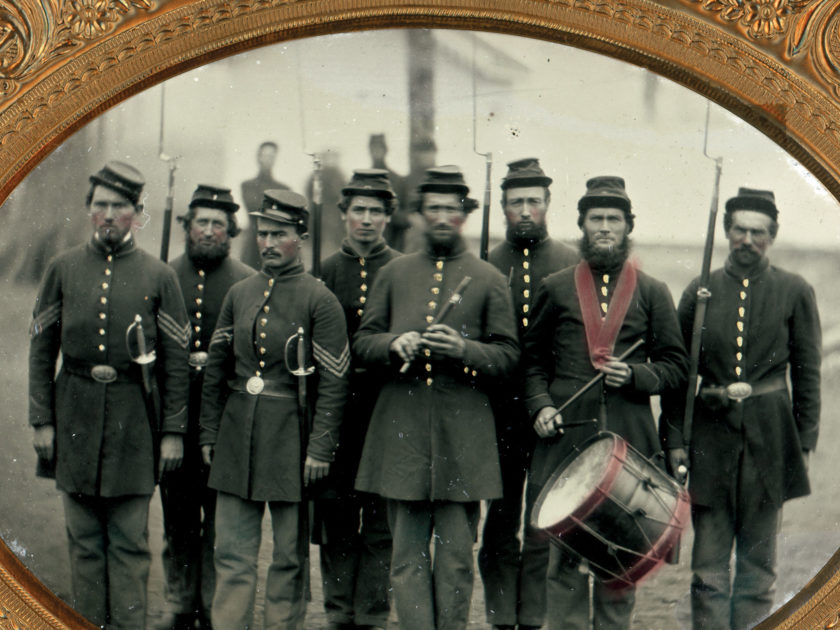
The relationship of this infantry fifer’s firmly planted feet to his turned head engaging with the camera creates dynamic tension. It leaves an impression that his body is about to spring back into position after he blows into his fife, like a corkscrew. This pent up energy leaves one with a sense that he is playing his instrument. But he did not hold his breath during the exposure, as evidenced by the softer focus of the Manhattan revolver in his belt. He stares directly at the camera lens with intensity, creating the impression that his fifing is as high quality as the composition of this portrait.
The position of the fife suggests that he is right-handed. The placement of the sword is key to the composition. The right-handed hilt of the sword pressed against his right hip rather than his left, likely the choice of the photographer, balances the composition. If the revolver and sword had been placed on the other side of his body without changing his stance, the implied line created by his pose and the slight diagonal line created by the bottom of the backdrop would result in an unbalanced composition—the fifer appearing about to fall. —Rick Brown

A greatcoat-clad fifer and drummer pose playing their instruments. Note the cap insignia with the company letter F in the center of a wreath and a two-letter regimental brass below it. Also of interest is the presence of a musket and other accouterments in the lower right-hand corner.

Where there is a drummer, one will normally find a fifer. In this street scene of about 30 infantrymen, he stands next to the drummer and company sergeant. Note the citizens perched in doorways, window frames and porch, the large Stars and Stripes draped above the column of soldiers, and what may be the photographer’s wagon parked next to the fifer.

An infantry bandsman poses with a fife and flute. His musician’s uniform and sword are standard issue and his Hardee hat has an unconventional crown. He likely used the fife for military business and the flute for camp entertainment.

A principal musician identified as “Cousin Seymour” wears the regulation dress of his rank, including sergeant’s chevrons with a star at the center, non-commissioned officer’s sword and a cap with wreath and US insignia. A pencil inscription on the back of the mount dates this portrait to Dec. 9, 1862.

A lone fifer stands front and center in this group of federal enlisted men and non-commissioned officers. A group of soldiers, perhaps company officers, stand watch in the background.

Michael Wilhite, a lifelong lover of martial music, answered the call to serve his country in the early fall of 1861, when he enlisted as a musician in Company C of the 33rd Indiana Infantry. Born one of 15 children in Oldham County, Ky., his family migrated to central Indiana, where Wilhite spent most of his life. Ironically, he spent the majority of his service in his birth state, including a victory at the Battle of Camp Wildcat, which earned the Indianans the nom de guerre “Wild Cats.” Chronic disease prompted his resignation after about a year, and persistent illness plagued him for the rest of his days. He passed in 1893 and was laid to rest in a rural cemetery outside of his small home village of Hall, Ind. An obituary noted that the patriotic Wilhite “was buried in his full [Army] uniform with his fife beside him, cherishing even in death what he so much enjoyed in life.”
This portrait is consistent with the look and feel of other early war soldier portraits taken in Indianapolis, Ind. Lovingly passed down through his descendants for nearly 160 years, Wilhite’s great granddaughter recently consigned it to an antique shop near Hall, as she had no further relatives to pass it to.

This second lieutenant and his non-commissioned officers are kept in line by the fresh-faced and unassuming fifer. Note the mouthpiece to control airflow attached to the end of his instrument.

An enlisted man wearing a regulation musician’s 9-button frock coat with shoulder scales grips his fife in much the same way as a drummer might hold a drumstick.

This veteran campaigner with gray-streaked beard presents his fife as if for inspection. A generous amount of gold paint has been applied to the ferrules at each end, likely German silver. Gold has also been painted over buttons, hatband, buckle, and 16A on his collar, indicating his service in Company A of the 16th regiment, state unknown.

This infantryman with a prominent necktie likely kept his fellow Vermonters in line with his fife. Note the presence of a mouthpiece just below the blow hole of his instrument. This device, typically cast in pewter and set in place with a screw, was often used by beginners to help them to constrict airflow. More specifically, to develop the embouchure necessary to direct a strong, steady stream of air through tight lips and into the instrument. Other terms commonly used to describe the mouthpiece, fipple and cheater, were not part of the 1860s vocabulary.

Sporting a Purinton and Ham havelock cap, this soldier in Company K of the 6th New Hampshire Infantry is ready for fifing action. A review of military service records reveals four men from this company and regiment who served as a musician. Based on age and enlistment date, the sitter may be 34-year-old David LeRoy, though no other evidence has yet surfaced to support this possible identification.

A fife, knife and revolver dominate this portrait of a Confederate soldier. The fife, which casts a strong shadow against his uniform jacket and belt plate, appears closest to the camera, followed by the D-Guard Bowie knife and the Colt Model 1855 side-hammer, also known as the Colt Root revolver. Also of note is his jacket, featuring cloth epaulettes anchored beneath the collar, hat with upturned brim, and the object displayed on the small table, possibly a housewife (sewing kit) or ditty bag.
A lock of hair pressed against the right side of the plate cause the distortion to the emulsion.

Running this gauntlet of infantrymen likely proved a more peaceful exercise than punishment, as indicated by the fifer standing between two drummers beneath a canopy of trees. A pencil inscription on paper tucked into the mat dates the photograph to Nov. 15, 1862, and references a photographer possibly named Bright.
Visual evidence suggests the men are located in a warm climate. Some soldiers wear only shirts and others have unbuttoned their coats. The trees appear deciduous and leaves have not fallen. The wooden structures in the upper left hand portion include an open space below the roof to allow heat to escape. This may suggest a southern location where they were not dealing with or concerned about the cold in mid-November.

A tinted fife is held in the hand of an enlisted man dressed in a sack coat and slouch hat.

The roster of the 25th Connecticut Infantry’s Company C counted two musicians in its ranks, including the fifer pictured here. Norman Fassett, a 42-year-old Vermont native, joined the 25th in November 1862 for a 9-month enlistment and served with the regiment in Louisiana. He survived his war experience and lived until 1893.

This fife-wielding lad carries a Model 1840 non-commissioned officer’s sword suspended from a shoulder belt. Above the chinstrap of his regulation cap is part of the infantry horn insignia. His jacket features three small buttons on the edges of the collar and the cuffs. According to MI Contributing Editor Mike Cunningham, this design is part of a militia uniform of which two examples survive. One is identified to a Cambridge, Mass., man said to have belonged to the Read Guard, a pre-war militia company.

Musicians armed with fifes and drumsticks posed for their portrait in a studio with a wood-plank floor and a simple canvas backdrop. All of the men wear standard uniforms with the exception of their privately purchased caps. The flautist seated on the right wears a Pattern 1826 eagle plate for his waist belt, perhaps a memento from his father or another person who served in the military at an earlier time. The gent with the waxed mustache standing on the right carries an uncommon knight’s head militia sword. The leader of this band, seated at the lower left, wears an officer’s frock coat without shoulder straps. Late war regulations indicate he may have been a second lieutenant, though his weatherproof cap cover suggests this image was made early in the war. The leader also appears in the separate portrait on the opposite half of the case. It may have been taken at a different time and place as evidenced by the lack of a cap cover and other differences.

The bearded Union volunteer pictured here is prepared for campaign with his fife and full gear—waterproofed knapsack and haversack, canteen and cap. The crown of the cap is marked with brass characters obscured by gold tint.

A fife major wears a regulation frock coat with taped front and sergeant’s chevrons. He holds his fife in one hand, and rests the other hand on a table next to his Hardee dress hat.

This musician shows off his fife with a mouthpiece, which is visible as a band towards the top of the instrument. It was likely made of rosewood or mahogany with brass or silver ferrules at each end to prevent the wood from splitting. His uniform and accouterments are noteworthy. The taping on his frock coat is rectangular instead of the standard coffin shape, and the cap is distinguished with a dark band and the company letter D, and three small brass letters that are likely initials for the name of unit to which he belonged. These letters would be superseded by state numbers upon activation for federal service. His waist and shoulder belt with frog are non-regulation, and the sword a non-commissioned officer’s pattern rather than a musician.

Holding his fife at the ready, this Union soldier wearing a slouch hat gazes into the camera lens with an expression that suggests a thoughtful disposition.
SPREAD THE WORD: We encourage you to share this story on social media and elsewhere to educate and raise awareness. If you wish to use any image on this page for another purpose, please request permission.
LEARN MORE about Military Images, America’s only magazine dedicated to showcasing, interpreting and preserving Civil War portrait photography.
VISIT OUR STORE to subscribe, renew a subscription, and more.

